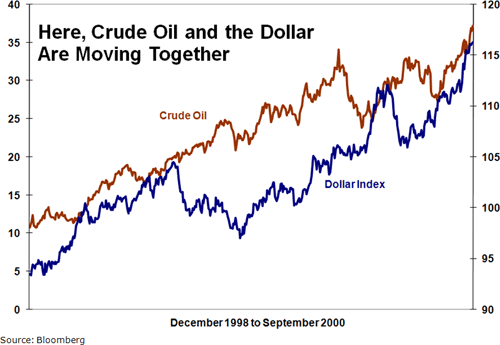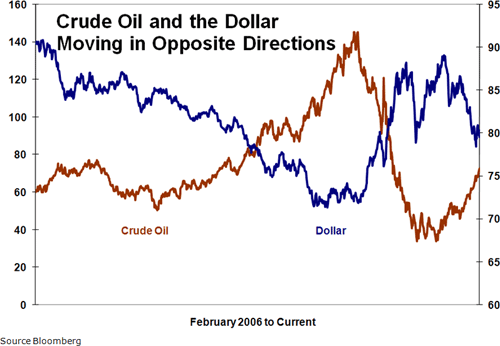What's the Relationship Between the U.S. Dollar and Commodities?
Commodities / US Dollar Jun 14, 2009 - 04:24 AM GMT Bryan Rich writes: The dollar can’t manage to find its way out of the limelight these days. There’s speculation about its demise and the loss of its world reserve currency status. It’s even blamed for higher gas prices.
Bryan Rich writes: The dollar can’t manage to find its way out of the limelight these days. There’s speculation about its demise and the loss of its world reserve currency status. It’s even blamed for higher gas prices.
Moreover, the mainstream media has attributed much of the recent climb in commodity prices to recent weakness in the dollar. On the surface, it’s a logical enough argument. After all, commodities like gold, oil, and grains are all priced in dollars.
Therefore, if the dollar weakens the value of the commodity shouldn’t be penalized. With that logic, it should strengthen to maintain its value on the global stage.
So all things remaining equal, the commodity should move in the directly proportional opposite direction of the dollar.
The only problem with this argument is that all things never remain equal …
 |
| As the dollar rallied last week, so did the price of oil. |
Market analysts, traders and journalists will always go to the stable of cause-and-effect market relationships to explain the day-to-day moves in financial markets.
For instance, weeks ago it was the weakness in U.S. Treasury bonds that was weakening the dollar. Then last week, it was the weakness in Treasury bonds that was strengthening the dollar.
And now, the recovery in commodity prices over the last fourteen weeks is being linked to a weak dollar. But as the dollar rallied last week, so did oil — a contradiction to this relationship.
So What Gives?
Is there a legitimate price relationship between the dollar and commodities? Or is it just market fodder to attempt to explain and justify the market activity?
That depends on the time period you look at …
For example, from December 1998 to September 2000 the relationship of oil and the dollar was positive, as shown in the chart below. When one went up, the other went up.

On the other hand, since February 2006, the relationship has been negative. Take a look at the following chart: When oil was crashing, the dollar was rising sharply. And over the past four months oil has recovered and the dollar has fallen.

Of course, these are just two isolated periods of time that I’ve used here to demonstrate exact opposite relationships.
However, over longer periods the influence of the dollar on oil, or oil on the dollar, is found to have no statistical significance. There’s not a significant positive or negative correlation. Consequently, statisticians would conclude that the dollar and oil have nothing to do with one another.
So if the dollar is not causing crude oil to surge, then what is?
Oil and the Dollar … Driven by the Same Factors
The move in oil and other commodities, along with stocks, bonds and currencies, are tracking one key thing: Perception of the health of the global economy.
When the economic and financial crisis commenced, oil and other commodities prices declined aggressively. In fact, the CRB Index, an index that measures a basket of commodities, ultimately fell 58 percent. At the same time, the Dollar Index rallied 25 percent.
That’s because both were driven by the fear and uncertainty surrounding the global economy. Capital fled all risky assets — commodities included — and found safety in U.S. Treasuries via the U.S. dollar.
Now, oil is moving higher and the dollar has been moving lower. This time it’s a retracement of that flight to safety trade. It’s money flowing back into commodities and other higher risk assets and out of the safety of U.S. dollars and longer-term U.S. Treasuries.
 |
| The growing perception that a recovery is near, is driving money out of the dollar and back into commodities. |
It’s clear that this current rise in commodity prices and fall in the dollar are not inflation-oriented like most are labeling them. Since this retracement began in March, coinciding with Fed Chairman Bernanke’s first mention of “green shoots,” the U.S. stock market has climbed 44 percent … the CRB Index is up 33 percent … crude oil up 120 percent … and copper up 97 percent.
But the Dollar Index has lost only 12 percent. Not exactly the tick-for-tick linkage that many would suggest.
Also, gold, the notable inflation hedge, has risen only 3 percent during this period. That tells me that this entire move has nothing to do with inflation and everything to do with a retracement of the 2008 crash in asset prices. And it’s driven by the growing perception that recovery is near.
Market participants are easily swayed toward the recovery argument. It’s an easy camp to be in, because it aligns perfectly with self-interest. We are in the most global-reaching recession ever, so it makes sense that the masses would pounce on any glimmer of hope to build an optimistic scenario about recovery. But those glimmers of hope are found within a structurally injured global economy.
This retracement has fed optimism, and optimism has fed the retracement. What’s more, this optimism has led to complacency, which has led to an underestimation of the underlying risks associated with the broadest and deepest economic recession since the Great Depression.
For that reason, I think this run-up in commodities and stocks provides the perfect opportunity to reduce risk — not add it.
In other words: Today’s winners could soon be tomorrow’s losers.
Regards,
Bryan
This investment news is brought to you by Money and Markets . Money and Markets is a free daily investment newsletter from Martin D. Weiss and Weiss Research analysts offering the latest investing news and financial insights for the stock market, including tips and advice on investing in gold, energy and oil. Dr. Weiss is a leader in the fields of investing, interest rates, financial safety and economic forecasting. To view archives or subscribe, visit http://www.moneyandmarkets.com .
Money and Markets Archive |
© 2005-2022 http://www.MarketOracle.co.uk - The Market Oracle is a FREE Daily Financial Markets Analysis & Forecasting online publication.



